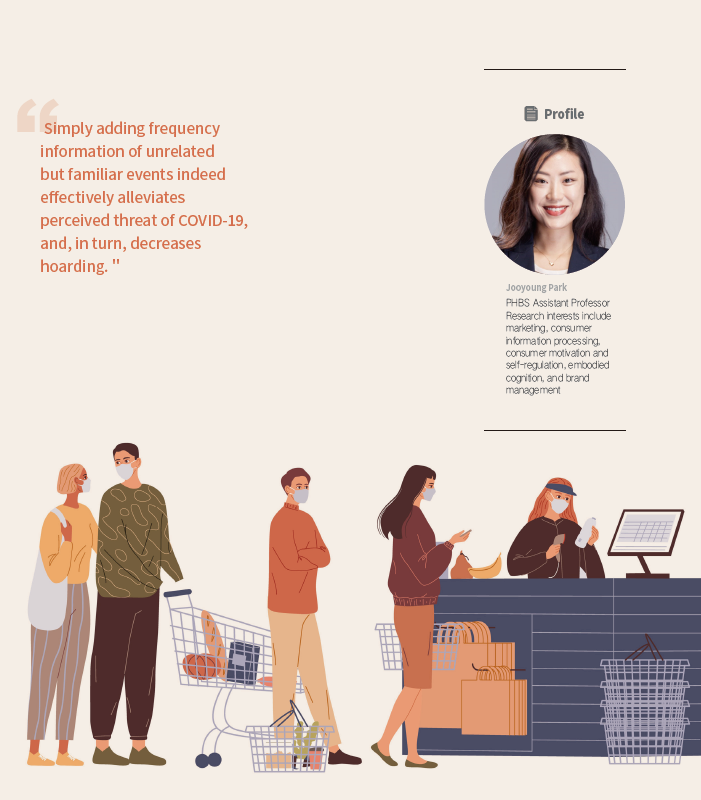Amid the COVID-19 outbreak, many people flocked to supermarkets to buy toilet paper. This was not limited to a particular country but occurred worldwide. The act of collecting an excessively large quantity of possessions is called hoarding [1]. Why did people collect toilet paper way more than they needed? Were they simply preparing for the unpredictable future, or irrationally panicking? More importantly, how can we prevent such panic buying that disrupts the distribution of necessities? Although infectious disease cues such as common cold or flu have always been present, COVID-19 is an unprecedented outbreak with frightening speed of spread around the globe.
Further, limited knowledge and uncertainty of the virus led to a flawed assessment of risk. Research has suggested that infection-related cues shape our behavior. Uncertainty and unpredictability involved in infectious diseases like COVID-19 create strong emotional and behavioral reactions, including overestimated threat perception and unnecessary hoarding.
Need for Self-Protection and Control under Threat
Humans have fundamental motives for self-protection and control. Thus, when faced with disease threats, safety-seeking is a natural response. Whereas threat sometimes leads to desirable behavior, such as following health-protective measures, it also causes irrational behavior. At the end of February and early March in 2020, over-purchasing of necessities spread around the globe. Although hoarding can be seen as unnecessary or irrational, people may engage in it to regain perceived control under threatening circumstances. They can control at least the items that may become scarce during a pandemic. However, as panic buying causes temporary shortages and interrupts the distribution of necessities, policymakers, retailers and marketers should carefully implement health-related communications that help people manage emotional distress and behaviors.
Strategies to Decrease Threat and Panic Buying
Imagine that you were reading a newspaper and found an update on the coronavirus (e.g.,“Worldwide Coronavirus Cases (up to 10:00 GMT on March 19 2020): 220,877).” How would you feel? You may experience overwhelming fear, seeing such a large number of deaths by an unknown virus. Would your assessment of the risk and threat of the virus differ if you see additional information (e.g., “Worldwide Car Crash Deaths (from January 1 to March 192020): 260,877”) along with the same information on the coronavirus?
Frequency judgment is often systemically biased by contextual information or even irrelevant information [2]. The bias is more likely to occur when a target event is unfamiliar or rare. However, frequency judgment of such an unfamiliar event can be improved when the information of the target event is combined with the information of a relatively more familiar event. Thus, one way to correct the overestimation of a usual disease can be showing comparative statistics of a familiar event such as car accidents and flu statistics. In a series of experiments [3], my coauthors and I find that simply adding frequency information of unrelated but familiar events indeed effectively alleviates perceived threat of COVID-19, and, in turn, decreases hoarding.
Who is More Vulnerable to Threat Cues?
People assume that the decisions we make in the moment are the outcomes of who we are now. But, from the evolutionary perspective, growing research has documented that the environment people were exposed to when growing up, called childhood socioeconomic status (SES), often better predicts people’s decisions and judgments in adulthood. In another recently published paper [4], my coauthors and I find that the effect of health communication messages such as adding comparative statistics or positive statistical information on perceived threat and stockpiling intention depends on childhood SES. There are at least two reasons. Working memory plays a critical role in interpreting information, reasoning, and regulating emotions. However, childhood poverty can impair working memory due to repeated experiences of stress during childhood. Impaired working memory can impede the processing of contextual information for people with low childhood SES. Furthermore, exposure to cumulative psychological and physical stressors can also impair people’s affect-based processing such as recognizing emotional faces. Thus, people with low (vs. high) childhood SES may exhibit less emotional responses to negative information. In three experiments, we find converging evidence showing that additional statistics of a familiar event is more likely to lower stockpiling intention for people who grew up in benign environments (i.e., high childhood SES). They could better process information in the presence of a threat. But, people who grew up in adverse, resource-scarce environments could be not only vulnerable to threatening events, but are also less responsive to communication messages.
How to Stop People Overreacting during a Pandemic?
Simply providing additional information of a familiar event can effectively alleviate people’s emotional and behavioral reactions to information about a life-threatening disease. Thus, to decrease people’s perceived threat and panic buying amid the COVID-19 pandemic, governments or health authorities should provide extra information of a comparative event in their communications. In contrast, in countries where lockdown and social distancing are critical, but people are not fully adhering to the recommendations, authorities should avoid using such comparative statistics. Further, our findings suggest that such communication messages are effective for those who grew up in relatively benign, resource-rich environments. Thus, government bodies need to consider using different communication strategies depending on people’s socio-economic status.
[1] Kirk, C. P., and L. S. Rifkin 2020.“I'll trade you diamonds for toilet paper: Consumer reacting, coping and adapting behaviors in the COVID-19 pandemic,”Journal of Business Research , 117, 124-131.
[2] Tversky, Amos, and Daniel Kahneman (1973).“Availability: A Heuristic for Judging Frequency and Probability. Cognitive Psychology ,5(2), 207-232.
[3] Kim, Jungkeun, Marilyn Giroux, Hector Gonzalez-Jimenez, Seongsoo Jang, Jooyoung Park, Jae-Eun Kim, Jacob C. Lee, and Yung Kyun Choi (2020)“Nudging to Reduce the Perceived Threat of Coronavirus,”Journal of Advertising , 49 (5), 633-647.
[4] Kim, Jungkeun, Marilyn Giroux, Jae-Eun Kim, Yung Kyun Choi, Hector Gonzalez-Jimenez, Jacob C. Lee, Jooyoung Park, Seongsoo Jang, and Seongseop (Sam) Kim (2020),“The Moderating Role of Childhood Socio-Economic Status on the Impact of Nudging on the
Perceived Threat of Coronavirus and Stockpiling Intention,”Journal of Retailing and Consumer Services , 59, 102362.
By Jooyoung Park
Published in the PHBS Magazine















